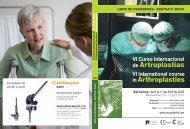cadera / hip - Active Congress.......
cadera / hip - Active Congress.......
cadera / hip - Active Congress.......
Create successful ePaper yourself
Turn your PDF publications into a flip-book with our unique Google optimized e-Paper software.
MIÉRCOLES / WEDNESDAY<br />
136<br />
ment of the greater trochanter with intact<br />
attachment of the gluteus medius muscle. A<br />
subtrochanteric shortening osteotomy fi xed<br />
with prosthetic stem was the other method.<br />
During the “Lord-period” exact rasping of<br />
the proximal femur and diaphysis distal to<br />
osteotomy and locking the proper rotation by<br />
step method was tedious and time consuming.<br />
Functional results, ROM and abduction<br />
strength were some better with the trochanter<br />
transfer method, although the radiographic<br />
result looks more anatomic and nicer after<br />
the subtrochanteric shortening technique.<br />
Lengthening of the leg was also easier with<br />
the fi rst method. To day we use the latter<br />
technique combined with angular and rotation<br />
correction in cases after low seated unilateral<br />
Schanz osteotomy. With the modern modular<br />
stems with fl uted distal part the procedure is<br />
much easier and faster.<br />
Patient material. The methods are applied<br />
for all grades of DDH, arthrogryphosis,<br />
diastrophic dysplasia, congenital coxa vara<br />
and all kinds of dysplastic <strong>hip</strong>s with osteoarthrosis.<br />
Results. Our experiences and results have<br />
been published in many articles (J Bone Joint<br />
Surg Br. 1990; 72:205-11, Clin Orthop Relat<br />
Res. 1993; 297:71-81, Acta Ortop Scand.<br />
1997; 68:77-84, J Bone Joint Surg Am.<br />
2003; 85:441-7, J Bone Joint Surg Am. 2006;<br />
88:80-91). In the last article Antti Eskelinen<br />
et al. reports results of 68 consecutive <strong>hip</strong><br />
replacements performed in DDH-patients<br />
with high dislocation. They were operated<br />
on between 1989-94. Follow-up time was<br />
12,3 y. Harris <strong>hip</strong> score increased from 54 to<br />
84 points. Trendelenburg sign was negative<br />
in 92% of the cases. With revision because<br />
of aseptic loosening as the end point the ten<br />
year survival rate for press-fi t porous coated<br />
acetabular component was 94,9%(95% confi<br />
dence interval, 89,3% -100%), but all the 9<br />
threaded cups loosened and all but one had<br />
been revised already. There were 6 revisions<br />
of the press-fi t cups because of liner wear and<br />
osteolysis, and 7 patients were scheduled for<br />
liner revision because of wear (1-5mm). The<br />
rate of survival for the DDH stem (proximally<br />
porous coated, Biomet Inc.), with revision because<br />
of aseptic loosening as the end point,<br />
was 98,4% (95% confi dence interval , 96,8%<br />
-100%)at ten years. One malpositioned stem<br />
perforated the posteromedial cortex of the<br />
femur. Two early dislocations occurred because<br />
of excessive anteversion of the stem.<br />
There were four transient nerve palsies, two<br />
peroneal, one femoral and one superior gluteal.<br />
In the case of the other peroneal nerve<br />
palsy, a big postoperative haematoma was<br />
evacuated on the fi rst postoperative day, and<br />
lengthening of the leg was reduced from 5 to<br />
4 cm with successful recovery.<br />
Conclusions. Replacement surgery of different<br />
types of <strong>hip</strong> dysplasia with osteoarthrosis<br />
is feasible with the presented techniques. In<br />
cases of high congenital dislocation we prefer,<br />
based on our experience, the technique<br />
of proximal shortening of the femur with distal<br />
advancement of the greater trochanter. If<br />
lengthening of the leg is desired more than<br />
3 cm, neurological status is controlled today<br />
with perioperative ENMG. The technique of<br />
segmental shortening with angle correction,<br />
we use only in cases after low seated unilateral<br />
Schanz osteotomy. Nowadays hard on<br />
hard articulations are our fi rst choice to avoid<br />
wear and osteolysis.<br />
PREVENTION AND<br />
TREATMENT OF RECURRENT<br />
DISLOCATION IN THA<br />
R. Geesink<br />
University Hospital Maastricht, Netherlands





